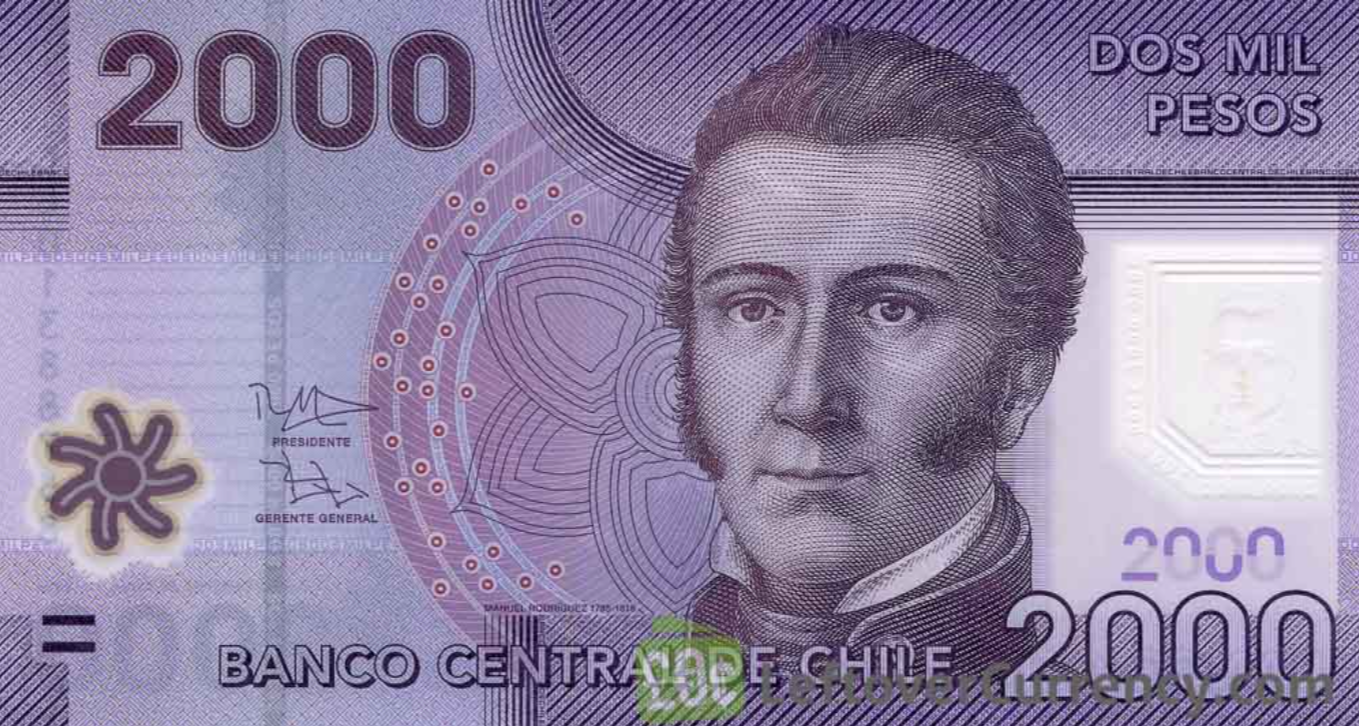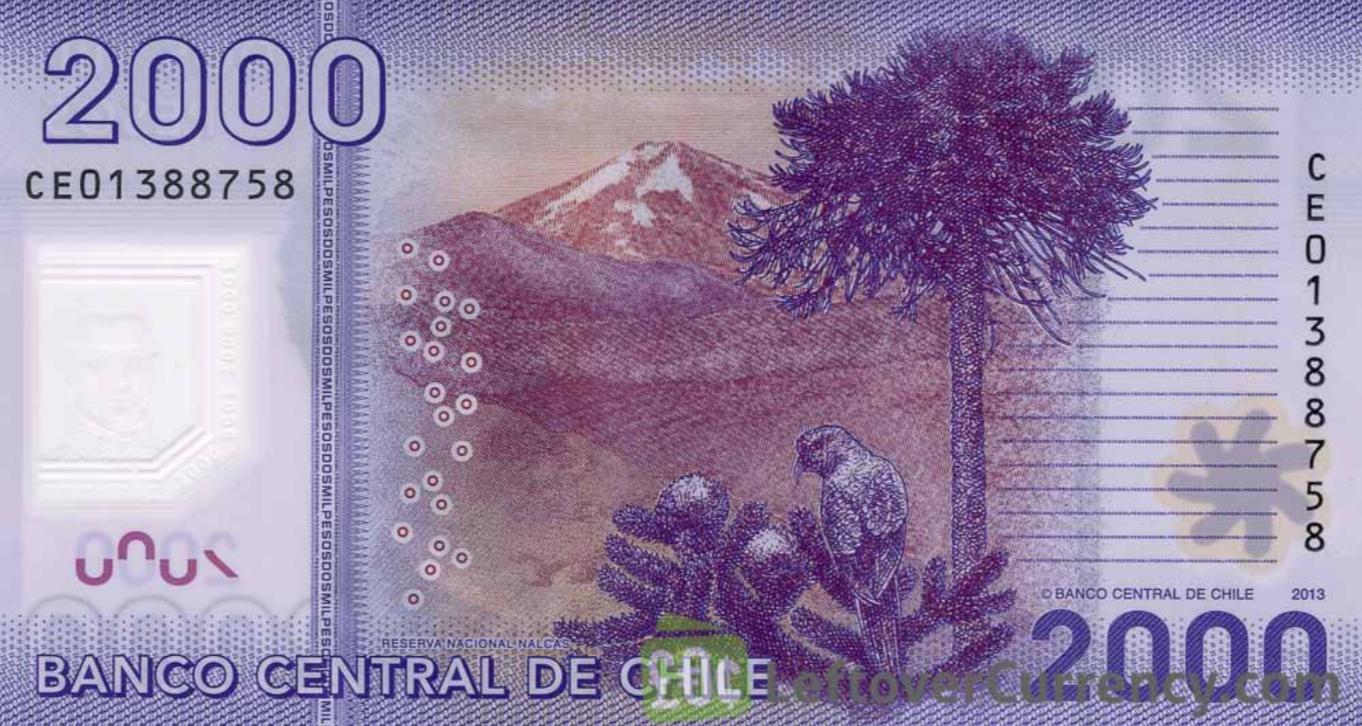History Notes
The currency of every country tells a lot about what that country celebrates and who they hold up as important figures to their success. Here in Chile, the first bill starts at 1000 Chilean Pesos (CLP) which is represented by the ‘$’ symbol and goes up to $20,000 CLP. However, you would never say '“1000 pesos” when referencing an amount you would say “1 Luca”. A Luca in colloquial Chilean Spanish represents 1000 CLP. The exchange rate with the USD is 721.80 CLP to every 1 USD. That means that dinner can be $50,000 CLP which your waiter would reference by saying “50 Lucas”. It just makes sense to keep it shorter.
What or, more importantly, who is it that is on this money that I am using every day to pay for taxis and groceries? This is something I wonder every time I pull out a bill, which is cleverly cut so that the bills descend in size from the $20,000 CLP note to the $1,000 CLP note. This week I finally took some time to look up the Chilean history that is portrayed on these notes. Here is a short history of Chile as told by their money.
Note: I am not going to be going into the history of the parks pictured on the back of these notes but they are worth Googling to see their full beauty.
CLP 1,000
Front: Ignacio Carrera Pinto (1848-1882)
Ignacio Carrera Pinto is a Chilean hero from the War of the Pacific (fought between 1879 - 1884, Chile and a Bolivian-Peruvian alliance disputed Chilean claims on Bolivian territory that bordered the Pacific). Ignacio was born into a wealthy and well-connected family in Santiago. When the war broke out, he joined the military and quickly rose through the ranks to Captain of Chacabuco's Fourth Company. The company consisted of 77 men who are regarded in Chile as the "Héroes de la Concepción" While they were guarding the Peruvian town of La Concepción, they were ambushed by 400 Peruvian soldiers and large groups of natives. Every member of the Fourth Company fought to the end and was killed in La Concepción. For the fighting spirit exhibited by Carrera and his men, Carrera was hailed a hero.
Back: Parque Nacional Torres Del Paine
CLP 2,000
Front: Manuel Rodríguez Erdoíza (1785-1818)
Rodríguez was a Chilean lawyer and guerrilla leader who was considered one of the founders of independent Chile. His short life - he was assassinated at the age of 33 - was remarkable in what he could accomplish. In September 1810, a national government (Primera Junta Nacional de Gobierno) was formed in the absence of the Spanish monarch. From this interim government, the Chilean Independence movement was born. In 1811 alone, Rodríguez was: appointed attorney for Santiago de Chile, elected parliamentary representative for Talca, appointed Secretary of War, and conscripted into the army with the rank of captain. Rodríguez was the ideal spy for the war since his humble origins allowed him to pass for a commoner easily. He began creating disguises and communications systems in the name of Chilean independence—often carrying out his missions disguised as a monk, farmer, street merchant, domestic servant, or even as a woman. He uttered the words that would define him forever during one battle, “Aún tenemos patria, ciudadanos” (We still have a fatherland, citizens).
Back: Reserva Nacional Nalcas
CLP 5,000
Front: Gabriela Mistral (1889-1957)
Lucila Godoy Alcayaga, who is better known by her pseudonym Gabriela Mistral, was a Chilean poet-diplomat, humanist, and educator. She created her pseudonym by combining her two favorite poets, Gabriele D'Annunzio and Frédéric Mistral or, as another story has it, from a combination of the Archangel Gabriel and the mistral wind of Provence, France. Born into poverty, she began writing poetry at fifteen and publishing it in the local paper, never using her real name. In 1945 she became the first Latin American author to receive a Nobel Prize in Literature, "for her lyric poetry which, inspired by powerful emotions, has made her name a symbol of the idealistic aspirations of the entire Latin American world" Her poems focus on nature, betrayal, love, a mother's love, sorrow and recovery, travel, and Latin American identity being a mix formed from Native American and European influences.
Back: Parque Nacional La Campana
CLP 10,000
Front: Arturo Prat (1848-1879)
Agustín Arturo Prat Chacón was a celebrated Chilean naval officer and navy lawyer. During his 18 years naval career, Prat took part in several naval engagements, including battles at Papudo (1865) and the Abtao (1866). When he took his final exam to become a navy lawyer, he held the rank of lieutenant commander and showed up to the exam in full dress uniform, including his sword at his belt. Prat would go on to become a lawyer at the age of 28. When the War of the Pacific began, he returned to his former ship, the Esmeralda. He was killed in the Battle of Iquique on his ship in 1879. Following his death, his name became a rallying cry for Chilean forces, and Arturo Prat has since been considered a national hero. Prat's name is commemorated on numerous plazas (squares), streets, schools, buildings, four of Chile's major warships, and is the most popular street name in Chile - appearing in 144 locations.
Back: Parque Nacional Alberto de Agostini
CLP 20,000
Front: Andres Bello (1781-1865)
Andrés de Jesús María y José Bello López was a Venezuelan born humanist, diplomat, poet, legislator, philosopher, educator, and philologist, whose political and literary works constitute an important part of Spanish American culture. Bello spent the first part of his life as a teacher to Simón Bolívar, a Venezuelan military and political leader who led what are currently Venezuela, Bolivia, Colombia, Ecuador, Peru, and Panama to independence from Spain. Working to establish a new independent government, he went on a 19-year diplomatic mission to London. In 1829 he accepted a post in the Chilean Ministry of Foreign Affairs in Santiago, Chile, and was later named Senator of Santiago. He also took time to be a professor, as well as directing several local newspapers in Santiago. As a legislator, he was a key figure in the creation of the Chilean Civil Code. In 1842 his lobbying paid off, and the University of Chile was created. Belloheldd the title of the rector (president) of the university for 20 years.
Back: Monumento Natural Salar De Surire
Not only does this offer a glimpse into Chilean history, but it also shows where the pride of the Chilean people is grounded. Love of country and a constant pursuit for a better life are themes that unite us as humans, and I couldn’t be prouder to be living among the humans here in Chile.










